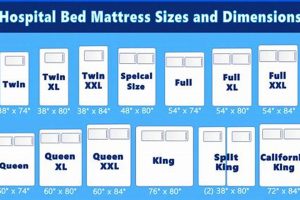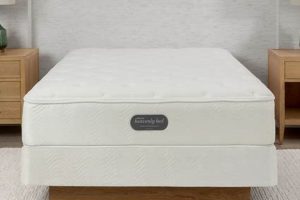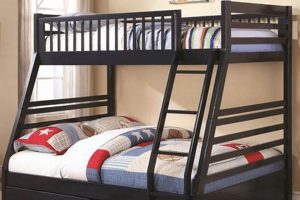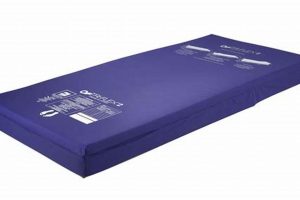Mattress encasements, specifically designed to be bed bug-proof, function as barriers, preventing bed bugs from infesting mattresses and box springs. These covers typically feature tightly woven fabric and zippered closures that impede the entry and exit of the pests. An example of their use involves completely sealing a mattress already infested with bed bugs, thereby trapping and eventually killing them within the cover.
The significance of utilizing such protective measures stems from their ability to control and prevent bed bug infestations, reducing the need for costly and potentially harmful pesticide treatments. Historically, reliance on chemical solutions was the primary method of bed bug control. The introduction and widespread adoption of mattress encasements provide a less intrusive and more preventative approach.
The following sections will explore the specific features required for effective bed bug-proof covers, proper installation techniques, maintenance practices, and the limitations of encasements in comprehensive bed bug management strategies. These factors are crucial in determining the overall efficacy of this preventative measure.
Efficacy Enhancement Strategies for Mattress Encasements
The following recommendations aim to maximize the effectiveness of mattress encasements in preventing and controlling bed bug infestations. Adhering to these guidelines will contribute to a more successful and long-lasting outcome.
Tip 1: Select a Certified Bed Bug-Proof Encasement: Ensure that the chosen encasement is specifically labeled and certified as bed bug-proof. These products undergo testing to verify their ability to prevent bed bug penetration. Look for certifications from reputable entomological sources.
Tip 2: Inspect for Imperfections Before Installation: Thoroughly examine the encasement for any tears, holes, or zipper malfunctions prior to installation. Even small imperfections can compromise the integrity of the barrier.
Tip 3: Install the Encasement Properly: Carefully follow the manufacturer’s instructions for installation. The encasement should completely enclose the mattress or box spring, with the zipper fully sealed and secured.
Tip 4: Regularly Inspect the Encasement: Conduct routine inspections of the encasement for any signs of damage or wear. Pay particular attention to seams and zipper areas. Repair any minor damage promptly with specialized repair tape designed for encasements.
Tip 5: Clean the Encasement Periodically: Follow the manufacturers instructions for cleaning the encasement. Regular cleaning helps to remove dust, allergens, and any potential bed bug hiding spots on the exterior surface. Avoid harsh chemicals that may damage the fabric.
Tip 6: Encase Both Mattress and Box Spring: For optimal protection, encase both the mattress and box spring. Bed bugs can infest both surfaces, and neglecting one can lead to continued infestation.
Tip 7: Combine with Other Preventative Measures: Encasements are most effective when used in conjunction with other bed bug control strategies, such as regular vacuuming, laundering bedding frequently in hot water, and professional pest control services when necessary.
By implementing these measures, the efficacy of mattress encasements in preventing and controlling bed bug infestations is significantly enhanced, leading to a more protected and sanitary sleeping environment.
The subsequent sections will delve into the practical considerations of integrating encasements into a comprehensive bed bug management plan, highlighting the need for a multi-faceted approach to effective pest control.
1. Barrier
The core functionality of mattress encasements in preventing and controlling bed bug infestations resides in their ability to act as a physical barrier. These covers are designed to completely enclose a mattress, preventing bed bugs from accessing it and establishing harborage. This barrier effect has a direct causal relationship with the goal of stopping bed bugs: by preventing access, the encasement effectively cuts off the bed bugs’ food source (human blood) and their ability to reproduce within the mattress itself. A real-life example of this is the use of encasements in hotels; encasing mattresses and box springs proactively minimizes the likelihood of infestations spreading from room to room.
The effectiveness of the “barrier” component depends on several factors, including the quality of materials and construction. Weak seams, compromised zippers, or tears in the fabric can negate the barrier effect, rendering the encasement ineffective. Therefore, choosing a high-quality, bed bug-certified encasement is critical. Further, regular inspection of the encasement is necessary to ensure the barrier remains intact. An illustrative example includes the use of a torn encasement, where bed bugs could establish within the unprotected area, rendering the encasement useless.
In summary, the physical barrier provided by a mattress encasement is essential in stopping bed bugs from infesting mattresses and box springs. The integrity of this barrier depends on material quality, proper installation, and regular maintenance. The application of encasements should be part of a multifaceted strategy that also includes thorough inspection and treatment of other infested areas. This approach is crucial for effective bed bug control.
2. Zippered closure
The zippered closure is a critical component of mattress encasements designed to prevent bed bug infestations. Its function is to completely seal the mattress within the encasement, preventing the entry or escape of bed bugs. The efficacy of the encasement in stopping bed bugs directly depends on the integrity and functionality of this closure mechanism. A compromised zipper, even with small gaps or openings, can negate the barrier effect of the encasement, allowing bed bugs to infest or escape from the mattress. An example would be a low-quality zipper where bed bugs could make their way into a mattress.
Specific design features of the zippered closure contribute to its effectiveness. Closures with tightly interlocking teeth and a fabric flap covering the zipper prevent bed bugs from squeezing through any minute openings. Durable materials are essential to resist wear and tear, ensuring the zipper remains functional over time. Regular inspection of the closure is necessary to identify any damage or defects that may compromise its integrity. A common example of where zippered closures are used are on luggage and clothing.
In conclusion, the zippered closure plays a vital role in the ability of mattress encasements to stop bed bugs. Its effectiveness hinges on proper design, durable materials, and regular maintenance. Understanding the significance of this component reinforces the need for careful selection and upkeep of mattress encasements as
a preventative measure against bed bug infestations, contributing to comprehensive pest management efforts.
3. Fabric weave
The fabric weave of a mattress encasement is a primary determinant of its effectiveness in preventing bed bug infestations. The tightness and type of weave directly impact the encasement’s ability to function as a barrier, preventing bed bugs from penetrating the material. A denser weave offers enhanced protection, while a looser weave may allow bed bugs to pass through, compromising the encasement’s purpose.
- Thread Count and Pore Size
Thread count, measured as threads per inch, is a key indicator of weave density. Higher thread counts typically result in smaller pore sizes within the fabric. The goal is to achieve pore sizes smaller than the smallest bed bug nymph, which can be less than 1mm in size. If the pore size is too large, bed bugs are able to get into the mattress, which renders the encasement useless. A high thread count and small pore size directly contribute to the encasement’s ability to stop bed bugs.
- Weave Type and Durability
Different weave types, such as plain, twill, or satin, offer varying levels of tightness and durability. Tightly woven fabrics, such as those with a plain or tightly packed twill weave, are more resistant to tearing and puncturing, which is necessary to prevent bed bugs. The weave type must be strong enough to withstand regular use and cleaning without compromising its structural integrity. An encasement with a strong fabric weave makes it able to stop bed bugs by keeping the barrier effect of an encasement.
- Material Composition and Breathability
The material used in the fabric, such as polyester, cotton, or a blend, also influences the weave’s performance. Certain materials may be inherently more resistant to tearing or have tighter weave structures. Breathability is also a consideration, as excessively dense weaves can trap moisture and create an environment conducive to mold growth. Manufacturers are innovating new weaves that allow breathability.
- Seam Construction and Binding
The fabric weave also extends to the seams of the encasement. If the seams are not properly sealed and stitched, bed bugs can pass through the seams, rendering the encasement useless. These seams are usually double stitched with binding covering the stitching. This also adds to the durability of the product.
The fabric weave is critical to understanding how mattress covers are effective at stopping bed bugs. The weave is directly correlated to how bed bugs cannot pass through the fabric to infest the mattress, and the higher the thread count, the safer the product becomes. There are several factors that contribute to the quality of the fabric’s weave, which is important to consider when deciding on a mattress encasement.
4. Proper fit
The efficacy of mattress encasements in preventing bed bug infestations is inextricably linked to achieving a proper fit. An encasement that does not completely and snugly enclose the mattress presents vulnerabilities that compromise its protective function. Ill-fitting encasements create gaps and folds, providing harborage for bed bugs to establish colonies within the mattress despite the presence of a cover. This diminishes the encasement’s value, transforming it from a preventative measure into a mere superficial covering. A real-world scenario involves encasements that are too large for the mattress, resulting in excess fabric bunching at the corners, thus giving bed bugs an area to stay and make their way into the mattress.
Proper fit is not merely a matter of aesthetics; it is a functional necessity. An encasement must conform precisely to the dimensions of the mattress, including its thickness, to maintain a tight seal. Oversized encasements offer space for bed bug activity, while undersized encasements may stretch and tear, creating entry points. Manufacturers typically provide size charts to ensure consumers select the appropriate encasement for their mattress dimensions. Another example where proper fit matters would be when the mattress size is queen, and someone uses a full size encasement, resulting in the inability to fully cover the mattress.
In conclusion, the significance of proper fit cannot be overstated in the context of bed bug prevention using mattress encasements. It directly influences the encasement’s capacity to function as a barrier. Ensuring the correct size and fit is a critical step in implementing a comprehensive bed bug management strategy. This practical understanding highlights the need for careful measurement and informed purchasing decisions to maximize the protective benefits of mattress encasements and mitigate the risk of infestation.
5. Durability
Durability is a paramount factor in determining whether mattress covers effectively prevent and control bed bug infestations. The longevity and resilience of a cover directly impact its ability to maintain a continuous barrier against these pests over an extended period. Compromised durability negates the intended protective function, rendering the cover ineffective.
- Material Strength and Resistance to Tearing
The inherent strength of the materials used in a mattress cover dictates its resistance to tearing, puncture, and abrasion. High-quality, tightly woven fabrics are better equipped to withstand the rigors of regular use, laundering, and potential snags. Covers constructed from weaker materials are more susceptible to damage, creating entry points for bed bugs. The use of durable fabrics plays an important role on whether a mattress cover can stop bed bugs.
- Seam Integrity and Stitching Quality
The seams of a mattress cover represent potential weak points in its defense against bed bugs. Reinforcement of seams through robust stitching techniques and durable thread is essential to prevent separation or unraveling. Poorly constructed seams are prone to failure, providing pathways for bed bugs to access the mattress.
- Zipper Quality and Closure Mechanism
The zipper serves as the primary means of sealing the mattress within the cover. The quality and construction of the zipper mechanism directly influence its longevity and resistance to damage. A flimsy or easily broken zipper compromises the entire encasement. A durable zipper ensures it will function properly for the duration of the cover’s use. The effectiveness is highly correlated to the zipper quality.
- Resistance to Degradation from Washing and Wear
Mattress covers must withstand repeated laundering without significant degradation in material integrity or protective properties. Fabrics that shrink, fade, or lose their weave tightness after washing compromise the cover’s ability to stop bed bugs over time. Durable materials must be used to keep the barrier between the mattress and the bed bugs effective.
In conclusion, durability underpins the long-term effectiveness of mattress covers in bed bug prevention. The selection of durable materials, coupled with robust construction techniques, is essential to ensure that the cover maintains it
s protective barrier throughout its lifespan. Compromises in durability negate the intended benefits, rendering the cover susceptible to penetration and infestation.
Frequently Asked Questions
The following section addresses common inquiries regarding the use of mattress encasements in mitigating bed bug infestations. The information provided aims to clarify misconceptions and provide guidance on the proper implementation of this preventative measure.
Question 1: Are all mattress covers effective against bed bugs?
No. Standard mattress protectors primarily safeguard against stains and moisture but lack the specialized design features required to prevent bed bug penetration. Only encasements specifically labeled as “bed bug-proof” offer the necessary protection.
Question 2: Can bed bugs bite through a mattress encasement?
A properly installed and intact mattress encasement, constructed from a tightly woven fabric, is impenetrable to bed bugs. Biting through the encasement is not possible if the material is of adequate quality and the cover is free from damage.
Question 3: What should be done if the mattress already has bed bugs before encasement?
Encase the mattress. The encasement will trap the bed bugs inside, eventually leading to their demise. Ensure the encasement is properly sealed to prevent escape. Monitor the encasement for any signs of breach. Over a period of time, the bed bugs should die.
Question 4: How often should mattress encasements be cleaned?
Mattress encasements should be cleaned periodically, following the manufacturer’s instructions. Regular cleaning helps remove dust, allergens, and potential hiding spots for bed bugs on the exterior surface. Typically, cleaning twice per year is sufficient.
Question 5: Can a mattress encasement guarantee complete bed bug elimination?
Mattress encasements are a valuable tool in bed bug management, but they are not a standalone solution. A comprehensive approach involving inspection, treatment of infested areas, and preventative measures is necessary for effective bed bug control.
Question 6: How can one verify that a mattress encasement is truly bed bug-proof?
Look for encasements that have been tested and certified by independent entomological laboratories. Certifications indicate that the encasement has met specific standards for bed bug resistance.
In summary, while mattress encasements can significantly reduce the risk of bed bug infestations, they are most effective when integrated into a broader pest management strategy. Proper selection, installation, and maintenance of encasements are crucial for maximizing their protective benefits.
The subsequent sections will delve into practical considerations for maintaining a bed bug-free environment beyond the use of mattress encasements.
Conclusion
The preceding analysis has established that mattress encasements, when properly selected, installed, and maintained, serve as a significant barrier against bed bug infestations. The ability of these covers to stop bed bugs depends critically on factors such as fabric weave density, zipper integrity, proper fit, and overall durability. While encasements alone may not guarantee complete eradication in the event of an existing infestation, their role in prevention and containment is undeniable. The implementation of mattress encasements represents a proactive strategy in safeguarding sleeping environments.
The informed application of preventative measures remains paramount in mitigating the pervasive threat of bed bug infestations. Consumers and establishments are encouraged to prioritize comprehensive pest management strategies, incorporating mattress encasements as a key component. Continued vigilance and proactive intervention are essential for maintaining healthy and sanitary living spaces.







